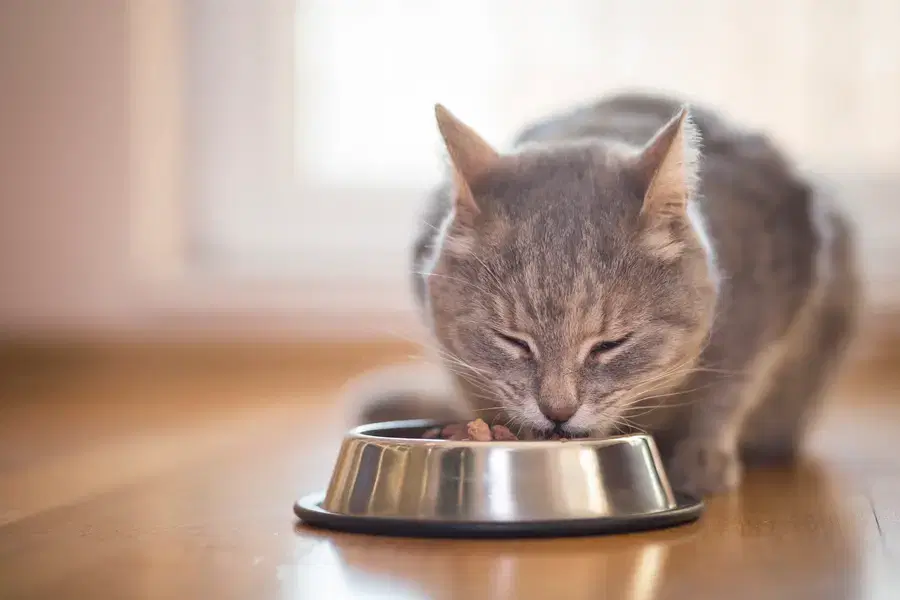It would be difficult to imagine the world without 2 things – mobile phones, and bread. People around the world thrive on bread, from enjoying a sandwich to having a party pizza. And why shouldn’t we? Is there anything more satisfying than a perfectly baked Margherita Pizza? Innumerable delicious dishes can be made with bread. As a loving pet parent, we may feel like sharing a piece with our feline friends. But is bread good for them? Do they even like it?
Can I Give My Cat Bread?
The short answer is 'Yes', cats can eat small amounts of baked bread, but they should never be given raw dough. That being said, there are a few more things you should know before handing your cat a piece of bread to enjoy. There are more than 20 types of bread and that’s without considering all of the different flavors that can be added. Depending on the ingredients, some breads are safe for a cat to eat, but others are toxic.
Do Cats Like Bread?
If you notice your cat investigating your toaster in the morning, or eyeing your plate as you enjoy your breakfast, they might be curious to try the bread you're enjoying. Cats tend to be interested in foods with interesting smells and textures, so it makes sense they they would be curious about bread or toast. However, while cats can have small pieces of bread, do not let them take a bite out of a sandwich. Common ingredients like onions, garlic, and spices can be toxic to them or can cause an upset stomach.
Is Bread Good for Cats?
Bread carries carbohydrates, a touch of protein, and modest doses of essential vitamins and minerals like B vitamins and iron. The nutritional makeup varies based on the bread type. Multigrain bread, for instance, packs a mix of nutrients, including fiber, protein, B vitamins, iron, magnesium, and selenium. Meanwhile, brown bread serves as a reliable source of fiber, B vitamins like folate and niacin, and minerals such as magnesium and selenium.1
However, it's crucial to note that while humans can benefit from these nutrients, a cat's digestive system is not set up in the same way and can't absorb them as efficiently.
Health Benefits of Bread for Cats
Bread isn't an ideal treat for cats. While a small amount might not pose an immediate threat, it doesn't offer much nutritional value. A tiny slice of white bread, for instance, provides 20% of the daily caloric requirement for a cat but lacks the essential nutrients they need. Read this article for nutrition tips for cats.
It's important to emphasize that baked bread is safe to give a cat but raw bread dough can be hazardous. The feline digestive system can't handle the dough's expansion which can lead to bloating and a distended stomach, causing severe discomfort and, in some cases, proving fatal.2 Additionally, yeast, a key ingredient in bread, produces carbon dioxide and ethanol alcohol. The presence of alcohol in the bloodstream can trigger seizures and respiratory failure in cats.
How Much Bread is Okay for Your Cat to Eat?
It's crucial to recognize that your cat is a carnivore, and most of its nutritional needs should be met through meat and specialized cat foods. Bread, ideally, shouldn't be a regular part of your cat's diet – in fact, it's best avoided altogether, and opt for treats that can offer more nutritional value, like fruits and vegetables. If you do give your cat bread as a treat, limit them to a small bite-sized piece.
The first time you give your cat a new food, look out for any signs of an allergic reaction or an upset stomach. If your cat enjoys the bread and doesn't show any signs of an adverse reaction, then you can gradually increase the amount you give them. Just remember to keep the total quantity to one or two pieces of bread, and to only give them bread occasionally.
How Should You Feed Bread to Your Cat?
Before sharing a piece of bread with your cat, it's important to know what to look out for:
Keep it simple: While you might enjoy your bread with various toppings and seasonings, it's crucial to keep it basic for your cat. Avoid ingredients like raisins, chocolate, and excessive salt, as these can be harmful to them. Additionally, steer clear of added sugars or artificial sweeteners.
Never Give Your Cat Raw Dough: As elaborated earlier, raw dough poses risks to your cat's health. If you're giving your cat homemade bread, make sure to keep them away from the dough until it has baked and cooled down.
What Can Happen if Your Cat Eats Too Much Bread?
If your cat happens to consume an excessive amount of bread, look out for signs of an upset stomach. You should contact your vet right away if you see symptoms of:
Diarrhea
Lethargy
The carbohydrates and gluten found in bread can pose challenges for a cat's digestive system, potentially causing imbalances due to the lack of essential nutritional content. Swift veterinary attention is essential to help address potential issues promptly.
Which Cats Should Not Eat Bread?
Bread is not a great addition to any cat’s diet. However, cats with specific dietary sensitivities or health conditions may be at higher risk for adverse effects from consuming bread. For example, diabetic cats may benefit more from healthy snacks like berries, or vegetables like broccoli or cauliflower.
Conclusion
When considering bread for your cat, it's best to limit options to either a small, unseasoned piece of baked bread or none at all. Bread doesn't offer any notable benefits to your cat and may potentially harm their digestive system. Our recommendation is to steer clear of incorporating bread into your cat's diet entirely to help avoid unwanted complications.

As Spot’s resident cat enthusiast, I am dedicated to researching and sharing information that helps pet owners take the best care of their pets. Pet ownership comes with it’s share of challenges, but my goal is to help make this journey easier.
“Is Bread Bad for You?” Healthline, https://www.healthline.com/nutrition/is-bread-bad-for-you, July 17, 2023.
“Can Cats Eat Bread?” Purina, https://www.purina.co.uk/articles/cats/feeding/what-cats-eat/can-cats-eat-bread, accessed Jan. 4, 2023.
The information presented in this article is for educational and informational purposes only and does not constitute or substitute for the advice of your veterinarian.












